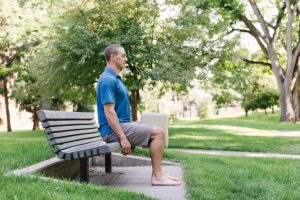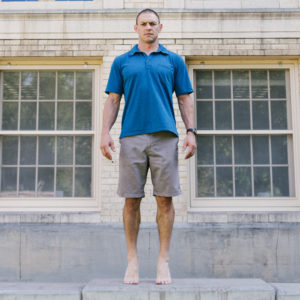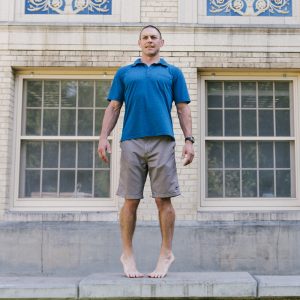Recently, we have had several clients come to see us with stories of having vertigo. Often times they share the information as an aside to why they’re really here. I want to explain why posture plays a huge role in the onset of vertigo for some people. We took the following from Pete Egoscue’s insights on vertigo published on the Sonima website. Be sure to check out the Egoscue E-cises Pete recommends at the end of his article:
VERTIGO
Vertigo is not pleasant. Its primary symptom is dizziness, sometimes so severe that the patient experiences nausea and vomiting, and it can last anywhere from a couple of hours to months and even years. Other symptoms range from headaches and eye twitching to sweating and hearing a persistent ringing in the ear. While the exact number of people who experience vertigo is not known, it has been estimated that 40 percent of all Americans will visit the doctor at some point in their lives because of vertigo. If you have had it, there really is no mistaking the sensation.
What Causes Vertigo?
Sometimes, vertigo is disease or illness-based, the result of a virus or a tumor, but doctors can quickly determine those cases. Most often vertigo is idiopathic, which is a medical term meaning no known cause or origin. In my experience, though, I’ve found most of those idiopathic versions of vertigo actually have a very specific cause—the position of the head. In other words, vertigo is usually about posture.
Humans are gravity machines; like the entire operating system of our universe, we rely on gravity to function, and because the body knows just how important our relation to gravity is, it offers redundant systems to make sure we have an accurate reading on our gravity field, i.e., the ground.
One of those systems is something called proprioception, which is defined as, “The unconscious perception of movement and spatial orientation arising from stimuli within the body itself.” In other words, your body knows where it is because it just does, and it’s constantly, instinctively, letting your brain know where the body is in relation to the ground. You have an inner sense of the ground on which you walk, and that’s why you don’t have to watch the ground when you walk.
Another system to modulate our relationship to the ground is the semicircular canals, which are three interconnected tubes in the deepest recesses of the inner ear. (Many of you probably remember this from high school biology). Those canals are filled with a fluid called endolymph, and that fluid flows freely when we are in proper relation to our field of gravity, thereby enabling us to function without losing our balance or getting dizzy. The final system is good old-fashioned eyesight. You can see the ground, and that helps you keep your balance. It’s much harder to walk with your eyes closed, and not simply because you’re worried about running into something.
Still, even with those redundant systems, many of us encounter vertigo, and that’s because of the position of our heads. When the body is properly aligned, the load-bearing joints of the shoulders, hips, knees and ankles are perfectly balanced from side to side and rest directly on top of each other; that enables the spine to maintain its designed “S” shape which in turn enables the head to rest directly on top of that spine, level so that the ears are directly perpendicular to the ground. When one of those joints deviates from its designed position, which is common in our sedentary lives, the body begins to compensate, usually resulting in a spine that morphs from an “S” to a “C” and a head that loses its proper relationship to its field of gravity—those ears are now angled.
When a head is out of balance, either leaning to one side or jutting forward, the systems designed to maintain balance start having an argument; the proprioception instinctively knows where the body and the ground are so conveys the right message to the brain; the eyes can always see where the ground is so confirm the message that proprioception sent. But those inner ears cannot see; they can only register the field of gravity by the position of the head, so when that head is out of position, it sends a message to the brain that is completely at odds with the message the other two systems sent. Enter vertigo.
The body adjusts, though, which is yet another example of how amazing the human form is. It almost always adjusts to a new positioning of the head, which is why, untreated, vertigo often disappears on its own within a day or two. But the head’s position will only continue to get worse, triggering new bouts of vertigo in the future. What’s more, for some people, their head has been out of position for so long that that fluid in the inner ear thickens and even develops microscopic calcifications that affix to the cilia of the inner ear, and that’s what contributes to those long-term bouts of vertigo that can last weeks and even years.
The solution is to return the head to its proper position. I’ve included a brief menu of Egoscue-cises (e-cises) to begin the process of repositioning the head, and they are good for short-term relief from the dizziness that comes with a fresh bout of vertigo. But for long-term relief, you need to realign your entire body and return it to its designed position so that both ears are perfectly perpendicular to the ground, the head is directly over the shoulders, and the spine is that letter “S.”
4 Posture Exercises to Cure Vertigo
Sitting Knee Pillow Squeezes, 3 sets, 20 reps

Three-Position Toe Raises, 3 sets, 10 reps in each position



Shoulder Rolls, 3 sets, 10 reps each direction

Standing Wall, 8 – 10 minutes

Known as the Father of Postural Therapy, Pete Egoscue has helped relieve thousands of people from their chronic pain, including many of the world’s leading athletes. For more information on Pete and any of his 25 clinics worldwide, go to egoscue.com.
By Pete Egoscue
Published on August 23, 2016
